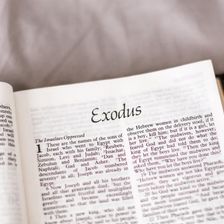
Revelation - Four Views (Part 1)
Individual Topics — Steve GreggNext in this series
Revelation - Four Views (Part 2)
Revelation - Four Views (Part 1)

Individual TopicsSteve Gregg
In "Revelation - Four Views," Steve Gregg presents four different approaches to interpreting the Book of Revelation. The book, a unique blend of epistle, prophecy, and apocalyptic literature, addresses the seven churches in Asia and includes both foretelling future events and sermonic aspects. Understanding the book's date, setting, and audience is crucial to interpreting its meaning, and while there are four views about the date of its writing, the strongest external evidence suggests it was written near the end of the reign of Domitian, with internal evidence suggesting an earlier date.
More from Individual Topics
74 of 111

Next in this series
Revelation - Four Views (Part 2)
Individual Topics
In this presentation, Steve Gregg explores four main views on the book of Revelation: historicist, preterist, futuristic, and idealist. While the futu
75 of 111

Sabbath Keeping
Individual Topics
Steve Gregg discusses the topic of Sabbath keeping in light of Jesus Christ's teachings and behavior. While the command to keep the Sabbath day holy w
72 of 111

Refuse To Be Offended
Individual Topics
In "Refuse To Be Offended," Steve Gregg emphasizes the importance of refusing offense to maintain healthy relationships between people. He argues that
Series by Steve Gregg

Cultivating Christian Character
Steve Gregg's lecture series focuses on cultivating holiness and Christian character, emphasizing the need to have God's character and to walk in the

Hebrews
Steve Gregg teaches verse by verse through the book of Hebrews, focusing on themes, warnings, the new covenant, judgment, faith, Jesus' authority, and

Exodus
Steve Gregg's "Exodus" is a 25-part teaching series that delves into the book of Exodus verse by verse, covering topics such as the Ten Commandments,

Nahum
In the series "Nahum" by Steve Gregg, the speaker explores the divine judgment of God upon the wickedness of the city Nineveh during the Assyrian rule

2 Thessalonians
A thought-provoking biblical analysis by Steve Gregg on 2 Thessalonians, exploring topics such as the concept of rapture, martyrdom in church history,

Habakkuk
In his series "Habakkuk," Steve Gregg delves into the biblical book of Habakkuk, addressing the prophet's questions about God's actions during a troub

2 Timothy
In this insightful series on 2 Timothy, Steve Gregg explores the importance of self-control, faith, and sound doctrine in the Christian life, urging b

Making Sense Out Of Suffering
In "Making Sense Out Of Suffering," Steve Gregg delves into the philosophical question of why a good sovereign God allows suffering in the world.

Knowing God
Knowing God by Steve Gregg is a 16-part series that delves into the dynamics of relationships with God, exploring the importance of walking with Him,

Nehemiah
A comprehensive analysis by Steve Gregg on the book of Nehemiah, exploring the story of an ordinary man's determination and resilience in rebuilding t
More on OpenTheo

How Can I Improve My Informal Writing?
#STRask
October 6, 2025
Question about how you can improve your informal writing (e.g., blog posts) when you don’t have access to an editor.
* Do you have any thoughts or

How Does It Affect You If a Gay Couple Gets Married or a Woman Has an Abortion?
#STRask
October 16, 2025
Questions about how to respond to someone who asks, ”How does it affect you if a gay couple gets married, or a woman makes a decision about her reprod

Fighting on Different Hills: Licona and Ally on the Resurrection of Jesus - Part 2
Risen Jesus
August 20, 2025
In 2004, Islamic scholar Dr. Shabir Ally and Dr. Mike Licona met at Regent University to debate the physical resurrection of Jesus. Both cases, a live

Faith Journeys: Similar Road, Different Conclusions - A Licona Ehrman Discussion
Risen Jesus
September 24, 2025
On the Risen Jesus podcast today, Dr. Michael Licona and Dr. Bart Ehrman join Justin Brierly on his Unbelievable podcast to discuss their faith journe

Should You Believe Things You Can’t Fully Comprehend?
#STRask
September 25, 2025
Questions about whether you should believe things you can’t fully comprehend, whether it’s just an arbitrary escape hatch to say God doesn’t require a

How Do I Reconcile the Image of God as Judge with His Love, Grace, and Kindness?
#STRask
October 20, 2025
Questions about how to reconcile the image of God as a judge with his love, grace, and kindness, why our sins are considered to be sins against God, a

When Is It Time to Walk Away from a Conversation?
#STRask
September 1, 2025
Questions about how to discern when it’s time to walk away from a conversation, and how to cope with people charging you with being prideful and legal

The Golden Thread of the Western Tradition with Allen Guelzo
Life and Books and Everything
October 6, 2025
Dr. Guelzo is back once again for another record setting appearance on LBE. Although he just moved across the country, Allen still made time to talk t

“Jesus Had Two Dads, and He Turned Out Just Fine”
#STRask
August 28, 2025
Questions about how to engage someone wearing a button that reads, “Jesus had two dads, and he turned out just fine,” and how to be kind and loving wi

Did God Create Us So He Wouldn’t Be Alone?
#STRask
November 3, 2025
Questions about whether God created us so he wouldn’t be alone, what he had before us, and a comparison between the Muslim view of God and the Christi

Mike Takes on World Ranked Debator on the Topic of Jesus' Resurrection from the Dead
Risen Jesus
August 27, 2025
Dr. Shane Pucket was ranked the 32nd best debater in the world in 2012. That year, he faced off against Dr. Michael Licona at Monroe Baptist Church in

John Thomson and the Shaping of American Presbyterianism with Stephen A. Fix
Life and Books and Everything
September 29, 2025
If you are looking for a deep dive into the history of early American Presbyterianism, you have come to the right place! Listen in as Kevin talks with

Is 1 Corinthians 12:3 a Black-and-White Tool for Discernment?
#STRask
October 27, 2025
Questions about whether the claim in 1 Corinthians that “no one can say ‘Jesus is Lord’ except in the Holy Spirit” is a black-and-white tool for disce

Is “God the Father” a Sexist Term That Demeans Women?
#STRask
September 29, 2025
Questions about whether “God the Father” is a sexist term that demeans women in general and mothers in particular, how long Hell has been there, wheth

If We Don’t Need to Learn to Hear God’s Voice, How Do You Explain These Verses?
#STRask
September 11, 2025
Questions about why, if we don’t need to learn to hear God’s voice, there’s a command to earnestly desire the gift of prophecy, why we would need to l